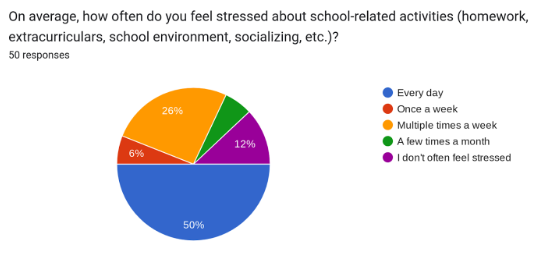Stress and Anxiety: How To Conquer It
It’s safe to assume that most students have dealt with stress or anxiety at some point in their lives, especially now that school is back in full force. In between homework, clubs, friends, family, and feelings, things can get overwhelming. Anxiety is the most common mental illness in America, affecting over 42.5 million people each year with 45% of American high school students reportedly feeling stressed, according to the Anxiety and Depression Association of America. With this being such a prevalent issue, what causes these feelings and how can students manage them?

Ideally, the body uses stress as a helpful tool capable of boosting energy and attention. It’s a natural alarm system and helps protect one from danger by reacting to external causes. Stress can be beneficial in an array of situations, such as finishing a last minute project or signaling a “gut feeling.” When stress becomes a constant force in a person’s life, it can have negative impacts on their physical health, such as high blood pressure, heart disease, extreme weight loss/gain, and menstrual changes.
There are two types of stress: acute and chronic. Acute stress is short-term stress that everyone experiences at one time or another; it’s that feeling after the jump scare in a horror movie or losing something important. Chronic stress is caused by external forces and lasts for as long as the stressor is present. When you have chronic stress, your body is constantly “on alert,” even when there is no danger.
“I think that learning how to handle stress is a skill,” says school Woodgrove psychologist Heidi Buckner. “When we are stressed our bodies are in fight or flight mode and that can affect our ability to sleep and eat, which in turn makes us more stressed. It’s a cycle.”
Woodgrove uses the “Sources of Strength” program in DenTime and FaceTime to promote healthy ways to cope with stress. These strategies include physical activity, spiritual activity, gratitude, etc.
Sophomore Jadyn Thomas says, “I cope with stress by going outside and playing with my dogs, practicing the piano, listening to music, or drawing.” Similar to stress, anxiety is an emotional response to something that’s bothering you. Anxiety is an internal side effect caused by external stress, and can be distinctly characterized by a constant feeling of dread or worry. When the feeling of anxiety becomes all-encompassing, it is known as an anxiety disorder.
Anxiety disorders can come in many different forms, including Generalized Anxiety Disorder (GAD), Obsessive-Compulsive Disorder (OCD), Social Anxiety, Panic Disorder, and Post Traumatic Stress Disorder (PTSD). Each anxiety disorder is caused by certain stressors and can be professionally treated in various ways. Even so, everyone has their own personal way of coping with stress and anxiety.
Senior Tanner Vincent says, “Usually when I’m stressed out, I try to talk myself down and put what I’m stressed about in perspective. Something along the lines of, ‘This is only one assignment, in one moment of my life. I most likely won’t remember it all by next month.’”
“Just take a moment to focus and breathe. It’s okay to take a minute to yourself,” Freshman Xander Bush advises to those who may be dealing with stress and anxiety.
Your donation will support the student journalists of Woodgrove High School. Your contribution will allow us to purchase equipment, attend conferences, and cover our annual printing and website hosting costs.












